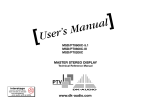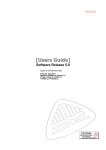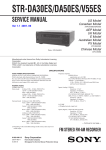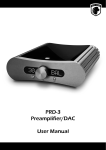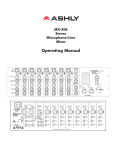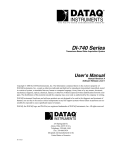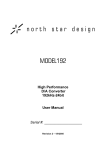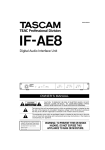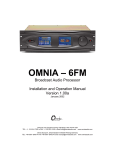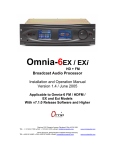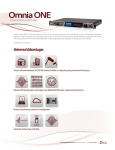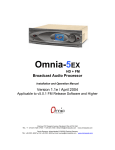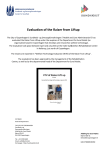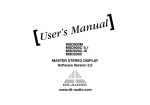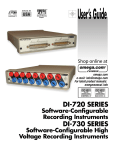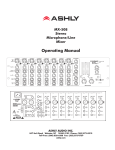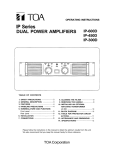Download 2090 Manual - Interstage
Transcript
l a u n a M s ’ r e Us [ MSD600M Technical Reference Manual MASTER STEREO DISPLAY www.dk-audio.com interstage Phistersvej 31, 2900 Hellerup, Danmark Telefon 3946 0000, fax 3946 0040 www.interstage.dk - pro audio with a smile ] MSD600M - Technical Reference Manual Copyright©2002 DK-Audio, Herlev, Denmark. All rights reserved. No part of this publication may be reproduced or distributed in any form, or by any means, without prior written consent from DK-Audio A/S, Denmark. Trademarks Analog Devices is a registered trademark of Analog Devices, Inc., USA. Crystal is a registered trademark of Cirrus Logic, Inc., USA. AKM is a registered trademark of Asahi Kasei Microsystems Co., Ltd., Japan. DK-Scale is a registered trademark of DK-Audio A/S, Denmark. Jelly-Fish™ is a registered trademark of DK-Audio A/S, Denmark. MSD600M - Technical Reference Manual Contents 1. 1.1 Introduction . . . . . . . . . . . . . . . . . . . . 1 This Manual . . . . . . . . . . . . . . . . . . . . . . 1 2. The MSD600M Audio Matrix . . . . . . . . 2 3. External Synchronisation and SRC . . . 4 4. 4.1 4.2 4.3 4.4 4.5 4.6 4.7 4.8 4.9 4.10 Hardware . . . . . . . . . . . . . . . . . . . . . . . Analogue Audio Inputs . . . . . . . . . . . . . Digital Audio Inputs . . . . . . . . . . . . . . . . Analogue Audio Output . . . . . . . . . . . . . Digital Audio Output . . . . . . . . . . . . . . . External Sync Source Input . . . . . . . . . . General I/O remote Interface . . . . . . . . . DSP Microcomputer . . . . . . . . . . . . . . . Flash-PROM . . . . . . . . . . . . . . . . . . . . . LCD Display . . . . . . . . . . . . . . . . . . . . . Power Supply . . . . . . . . . . . . . . . . . . . . 8 8 8 9 9 9 9 10 10 11 11 5. 5.1 5.2 Modules . . . . . . . . . . . . . . . . . . . . . . . . 12 Module Configuration . . . . . . . . . . . . . . 15 Mixing Modules . . . . . . . . . . . . . . . . . . . 15 6. Mounting . . . . . . . . . . . . . . . . . . . . . . . 16 7. Audio Connections – Breakout Cable . 17 8. Precautions . . . . . . . . . . . . . . . . . . . . . 18 9. Factory Presets . . . . . . . . . . . . . . . . . . 20 10. The “DK-Scale” PC-Software Program . . . . . . . . . . . . . . . . . . . . . . . . 22 11. 11.1 11.2 Software Upgrade . . . . . . . . . . . . . . . . 24 COM Port Selection . . . . . . . . . . . . . . . . 24 Update Procedure . . . . . . . . . . . . . . . . . 24 12. Appendix A. Specifications . . . . . . . . . 25 13. Appendix B. Mechanical Dimensions . 30 14 14.1 Appendix C. Pin Configurations . . . . . 32 Appendix C-1. Pin configuration for Utility Module . . . . . . . . . . . . . . . . . . . . 32 MSD600M - Technical Reference Manual Contents 14.2 14.3 14.4 14.5 15. 15.1 15.2 15.3 15.4 15.5 15.6 Appendix C-2. Pin configuration for Input Module MSD600M-Input/1 ............ Appendix C-3. Pin configuration for Input Module MSD600M-Input-2D/O and MSD600M-Input-4D/O...................... Appendix C-4. Pin configuration for Output Module MSD600M-Output/1 ....... Appendix C-5. Pin configuration for General Purpose I/O Module MSD600M-I/O-23..................................... Appendix D. Factory Presets . . . Appendix D-1. Factory Preset 0: Base Setup . . . . . . . . . . . . . . . . . Appendix D-2. Factory Preset 1: All Analogue . . . . . . . . . . . . . . . . Appendix D-3. Factory Preset 2: All AES . . . . . . . . . . . . . . . . . . . . Appendix D-4. Factory Preset 3: LR . . . . . . . . . . . . . . . . . . . . . . . . Appendix D-5. Factory Preset 4: LRCS Pro-Logic Surround Sound Appendix D-6. Factory Preset 5: LRCLsRs 5.1 Surround Sound . . . 32 33 33 34 . . . . . 36 . . . . . 36 . . . . . 38 . . . . . 40 . . . . . 42 . . . . . 44 . . . . . 46 15.7. Appendix D-7. Factory Preset 6: LRLsRsCCs 6.0 Surround Sound . 15.8. Appendix D-8. Factory Preset 7: LRClCrLsRs 7.1 Surround Sound . 15.9 Appendix D-9. Factory Preset 8: LCRLsRs 5.1 Surround Sound . . . 15.10 Appendix D-10. Factory Preset 9: LtRt Pseudo-Surround Sound . . . . . . . . 48 . . . . . 50 . . . . . 52 . . . . . 54 Registration Card . . . . . . . . . . . . . . . . . . . . . . 57 MSD600M - Technical Reference Manual 1 1. Introduction Congratulations! By purchasing a Master Stereo Display (MSD) from DK-Audio you have decided to actually "See What You Hear"! We are certain that your Master Stereo Display will prove an invaluable tool in your daily work. If you have any suggestions or points of view for future functions or options, we welcome your comments. Please write to DK-Audio at the address on the rear page of this manual, or call +45 44 85 02 55. You can also use the enclosed Registration Card to send us your remarks and observations. Your Registration Card is also the easiest way for you to receive up-to-date information from DK-Audio on future Master Stereo Display products. Please also check our website at www.dk-audio.com 1.1 This Manual This Manual is an addendum to the Software User Manual covering all aspects of the MSD Operating System. In this Manual all model specific information can be found. This includes mechanical dimensions, electrical specifications, hardware description, mounting descriptions, flow-charts, factory presets and pin-out descriptions. • For any question regarding the operation of the MSD unit please refer to the Software User’s Manual 2 MSD600M - Technical Reference Manual 2. The MSD600M Audio Matrix The Audio Matrix function of the MSD600M has become the very heart of the MSD unit. Almost all parameter settings, originates from the Matrix. The MSD600M features a full 32 x 16 Audio Matrix which allows up to 8 analogue or 32 digital input channels (mono), to be routed to any of max. 8 analogue/digital output channels and/or to their associated metering functions. Any input channel may be routed to any output, including separate Left/Right channels of an AES-3 stream. Therefore there are no restrictions of the routing of a signal. MSD600M - Technical Reference Manual 3 4 MSD600M - Technical Reference Manual 3. External Synchronisation and the Sample Rate Converter (SRC) The MSD600M have been designed to run on a fixed internal sample rate at 48 kHz. However the use of the External Sync Input enables the user to force the MSD600M to synchronise its internal sample rate to an external AES signal. Notes (page 5): 1 All input modules for the MSD600M are fitted with a SRC between the AES input and the MSD Internal Audio Bus. This enables several non synchronised AES sources to be synchronised and used as if originated from the same source. When monitoring the true peak value of an AES input signal it is recommended to bypass the SRC since it can alter the peak value of the signal. 2 The SRC Bypass switch selects between the Audio Data before or after the SRC. This data is the feed to the Audio Matrix. When the SRC is in Bypass mode the System Clock MUST be synchronised to the incoming AES signal. This can be done by applying the same input signal (or a signal synchronised to the input signal) to the external Sync Input. 3 The External Sync is mainly used in two situations. 1) The user will synchronise an AES Output signal from the MSD600M to an External source. 2) The user will bypass the SRC on one of the Input modules. This requires that the Internal System Clock is synchronised (set to the same Sample Rate) as the AES Input signal. 4 The External Sync Input. From the Info Menu the user can see if the MSD have detected and selected a valid External sync signal. This block controls the source of the System Clock. The MSD600M will automatically switch from the Internal Clock to the External Clock if a Valid AES signal is connected to the External sync input. 5 Internal 48 kHz Master Clock. This clock is used when valid External Sync have been detected. 6 The Control Processor is the brain of the MSD. One of many functions is to control the SRC function. This function will only happen when a user alters the SRC Bypass setting. To change this setting enter the Option menu under the Input Matrix Menu. MSD600M - Technical Reference Manual See notes opposite page! 5 6 MSD600M - Technical Reference Manual Since the unit’s internal sample rate also determines the AES output sample rate you can use the AES reference sync Input to synchronise the AES output’s sample rate to match (sync up to) any external equipment you might like to send AES data to. It is common that professional audio equipment such as mixing consoles are fitted with sample rate converters in their AES input stage. In these cases it is not necessary to synchronise the AES output signal. The MSD600M will auto-detect the presence of a valid AES reference Sync signal and in the case one is detected switch to this as its internal system sample rate clock. The Info Menu “Sync” will indicate if the MSD600M is synchronised to any AES reference sync Input. It is not possible manually to overwrite the external sync auto-detect feature. Once a valid sync signal is present the MSD600M will always select this for its system sample rate clock. Even though the AES-3 External Sync. Input will lock up to 96 kHz, the external synchronisation input should not be set to lock on any AES-3 signal higher than 48 kHz, as it may cause glitches in the audio stream. Synchronising to a lower sample rate than 48 kHz (like 44.1 kHz) will not be a problem. It is however not recommended to sync to a external sync source lower than 44.1 kHz since this will effect the ballistics of the MSD600M’s meter functions. When using the MSD600M with one of the DMU scales (which are true peak scales) it is recommended that the MSD600M SRC used are in Bypass mode. The reason is that the SRC under certain situations effects the peak value of the input signal. In all other PPM Scales where the displayed level is based on the energy of the signal and not the true peak value, the SRC will not effect any measurements. MSD600M - Technical Reference Manual 7 8 MSD600M - Technical Reference Manual 4. Hardware The MSD600M have been designed with the very best technology available today ensuring superb performance, high flexibility and an outstanding audio performance. 4.1 Analogue Audio Inputs The MSD600M is equipped with both analogue and digital inputs. An Analogue Audio input can be obtained by using the MSD600M-Input/1 Module combining both an Analogue and a Digital AES-3 Input. The latest version of the Analogue Input is based on a 24-bit Analogue-to-Digital converter (ADC) of the S/D type from Cirrus Logic®, the CS5360. The sample rate is fixed at 48 kHz. Combined with a transformer-balanced input stage it forms a very high performance Input stage. The analogue input on the MSD600M-Input/1 Input module is able to handle +24 dBm. 4.2 Digital Audio Inputs If interfacing to a Digital AES-3 Input signal there are three types of input modules to select from (see next section in this manual). Common for all is that they are designed around the Cirrus Logic® AES-3 receiver chip, the CS8420. This AES-3 receiver has not only become an industry standard but also contain the Sample Rate Converter (SRC) used by the MSD600M. The SRC ensures correct synchronisation of all AES-3 input sources, making it possible to source to several asynchronous AES-3 streams simultaneous. The CS8420 is able to lock on any sample rates between 32 kHz to 96 kHz and convert it to the used internal sample rate of 48 kHz (when no external sync. source is used). The Input stage to the AES receiver is transformerbalanced according to the AES specifications. This AES-3 Input stage will generally also interface to the consumer S/PDif format when grounding one of the balanced AES-3 input terminals. However, since the signal level (eye-pattern) of a S/PDif is not compatible with the AES-3 specifications there is no guarantee for an error free reception. MSD600M - Technical Reference Manual 4.3 Analogue Audio Output Just like the input module, MSD600M-Input/1, the output module MSD600M-Output/1 is equipped with both an analogue and a Digital AES-3 output. The Analogue Output is designed around the AK4324 24-bit Digital-to-Analogue converter (DAC) from AKM®. The converter is of the S/D type with an amazing dynamic range of 115 dB. The analogue outputs on the MSD600M-Output/1 module are electrically balanced and are able to output a +18 dBm signal level. 4.4 Digital Audio Output The Digital AES-3 Output found on the MSD600MOutput/1 module is a true transformer-balanced output specified by AES. The actual AES encoding is done by the Audio Matrix logic itself on the MSD600M. The AES-3 outputs will always be synchronous to the used master clock, which either can be driven from the external sync input or from an internal 48 kHz clock oscillator. 9 Combined with the SRC on the input modules this arrangement enables the MSD600M to be used as a high performance SRC taking an AES-3 input signal of any arbitrary sample rate between 32 kHz to 96 kHz and convert it to the internal used sample rate. 4.5 External Sync Source Input The External Sync Input on the MSD600M is using the same high quality Input stages as found on the MSD600M-Input/1, MSD600M-Input-2D/O and MSD600M-Input-4D/O modules just using an AES-3 receiver without any SRC. The MSD600M can be set to synchronise to an AES-3 signal in the range 32 kHz to 50 kHz. 4.6 General I/O remote Interface The Digital I/O module, MSD600M-I/O-23, provide an easy to use remote control interface for the MSD600M. At this time (2002) 19 out of the 24 10 MSD600M - Technical Reference Manual available port bits have been defined (The remaining bits can in the future be defined as both inputs or outputs). The Input is a standard TTL compatible input with a strong pull-up and an input protection resistor. 4.7 DSP Microcomputer and 16K-words of (24-bit) program memory RAM, on-chip. It runs with an instruction cycle of 25ns equals to 40 MIPS. The MSD600M's data processing is entirely based on a very powerful Digital Signal Processing (DSP) microcomputer chip. By using DSP all errors with ballistic and scaling found on older analogue VU-Meter based equipment is virtually eliminated. The Software Version referred to in the Info Menu is the Software running on this DSP Microcomputer. The used DSP is the Analogue Devices® ADSP2181, a single-chip microcomputer, optimised for digital signal processing (DSP), and other highspeed numeric processing applications. The computer has 16K-words of (16-bit) data memory RAM, 4.8 Flash-PROM (Program Storage Media) All programs executed by the DSP Microcomputer are stored in a FLASH-PROM integrated circuit. The flash-prom configuration allows new software versions to be downloaded via the RS232 serial communication port found on the Utility Module. MSD600M - Technical Reference Manual 4.9 LCD Display The MSD600M is fitted with the very best in LCD display technology: A high-quality, 640 (horizontal) x 480 (vertical) pixel, full-colour TFT LCD display with extra high contrast and viewing angle. The display has a dual tube cold cathode (CCFT) installed inside the unit for background illumination with an expected lifetime of approximately 50,000 hours. The display is controlled directly from the DSP using a Display Driver design developed by DK-Audio. There are several suppliers of TFT VGA displays, NOTE: LCD pixels turn black or radiate different colours The LCD is constructed with precision technology so 99.99% of the pixels are active, but of the remaining 0.01% there are pixels, that may be black or emit light constantly in a fixed colour. This phenomenon is not a malfunction and is therefore not covered by the 2-year factory warranty. 11 but with a very high variation in quality. DK-Audio is only using the very best TFT technology available today. These are a bit more expensive than commonly used LCD displays but so much better. Remember: “You See What You Hear”! 4.10 Power Supply The MSD600M is using an external power supply of the desktop type. This enables the MSD itself to be more compact for easy installation. The power supply is based on the switch-mode principle. Power input is through the 9-pin DSUB connector on the Utility Module found at the rear of the unit. • Recommended supply voltage range is 12-24V DC 24W NOTE: High Voltage Special care must be taken in a service or maintenance situation, as 600V AC is present on the PCB. 12 MSD600M - Technical Reference Manual 5. Modules There is a total of nine module slots at the rear of the display unit. One slot is used for the utility module and four slots for each input and output modules. Input and output modules can be installed very easily accommodating up to 32 digital AES-3 and/or 8 analogue inputs (mono) simultaneous with up to 8 analogue + 8 digital AES-3 outputs (mono). One of the output slots can alternatively be used for a 23-bit parallel digital In/Output module offering remote control functions. The Utility module is providing power connection, RS232 connection, AES reference Sync input and a VGA output connection. MSD600M - Technical Reference Manual 13 14 MSD600M - Technical Reference Manual The modular design of the MSD600M makes it easy to configure for any application. Currently the following Input/Output modules are available: AES-3 AND ANALOGUE AUDIO INPUT Module name: MSD600M-Input/1 Features: 1 Stereo transformer balanced Analogue Input + 1 Digital AES Input (24-bit). MSD600M-Input-2D/O 2 Digital AES Inputs (24-bit). MSD600M-Input-4D/O 4 Digital AES Inputs (16-bit). MSD600M-Input-SDI SDI de-embedder. 2 groups with a total of 4 Digital AES Inputs (24-bit). MSD600M-Output/1 1 Stereo Analogue Output + 1 Digital AES Output (24-bit). GPIO General Purpose I/O module. FITS INTO THE MSD600M MSD600M - Technical Reference Manual 15 5.1 Module Configuration 5.2 Mixing Modules Fully loaded the MSD600M will provide a total of 16 digital AES-3 inputs (32 mono channels) or 4 stereo Analogue (8 mono) + 4 digital AES-3 (8 mono) inputs. And at the same time providing 4 digital AES-3 (8 mono) + 4 stereo Analogue (8 mono) outputs. When mixing input modules of different types there are some guidelines for which input module must be placed in which slot. The four Input Module slots are numbered I1-I4, and must be inserted sequentially in these slots, i.e. the first Input Module in slot I1, the next in slot I2 etc. The four output Module slots are marked O1-O4 and output modules must also be inserted sequentially in these slots, i.e. the first Output Module in slot O1, the next in slot O2 etc. The following list is a priority list. The module with the highest priority (priority #1) must be placed first in the MSD starting from slot number 1. Modules with the same priority can be freely interchanged. Module name: MSD600M-Input-4D/O MSD600M-Input-SDI MSD600M-Input-2D/O MSD600M-Input/1*) MDS600M-Input/1 After installation of the required number of input/output modules, the MSD600M recognises the input configuration and automatically lists them in the Audio Matrix Menu ready to use. Priority Level: 1. 2. 2. 3. (New Model. Using Cirrus Logic®,CS8420, AES-3 receiver chip) 4. (Older Model. Using Analog Devices®, AD1892) *) The new MSD600M Input/1-module was first released in May 2002. An easy identification of the new MSD600M is that it is using the Cirrus Logic®, CS8420 AES-3 receiver where the older modules are using an AES-3 receiver from Analog Devices®, AD1892. 16 MSD600M - Technical Reference Manual 6. Mounting The MSD600M is supplied complete with mounting bracket and fittings, making it easy to mount the unit on any console or desk. The bracket makes it possible to adjust the unit both horizontally and vertically for the best viewing position. To mount the MSD600M in as flexible a manner as possible, always use the supplied base-plate. The enclosed fittings for mounting are: 1 x bracket (U-form), 1 x circular base-plate, 3 x finger screws with star-washers. Desk or console mounting screws are not supplied, contact your desk or console manufacturer if in any doubt as to mounting procedure. Mounting the unit if the MSD600M is to be turned both horizontally and vertically for the best viewing angle: Screw the base-plate to your console or work surface using two 4mm wood screws (or an appropriate alternative, depending upon the material). Place the bracket on top of the base-plate and secure using one of the supplied finger screws with star-washers. Now fix the MSD600M to the bracket with the two remaining finger screws. Insert the supplied star-washers between the bracket and cabinet. This allows the MSD600M to be turned both horizontally and vertically for the best viewing angle. Mounting the unit if the MSD600M is to be static mounted, allowing the unit only to be turned vertically: Screw the bracket directly to your console or work surface using two 4mm screws (or an appropriate alternative, depending upon the material). • When mounting, make sure to allow enough loose cable for the unit to be tilted and turned MSD600M - Technical Reference Manual 7. Audio Connections Breakout Cable The MSD600M is connected to your audio sources via a standard 15-pole DSUB socket on the rear of each input/output module. A standard breakout connection cable is available from DK-Audio for the Input, Output and Utility modules. The breakout cables have all the necessary DSUB connectors to XLR (audio in/out) connectors. Diagrams for all available breakout cables are available on our web site www.dk-audio.com. Detailed information regarding the Pin-outs on the various DSUB connectors is available in this manual, see Appendix C. • Refer to Appendix D-1 (page 36) “Factory Presets” for detail description on how to connect input/output modules, matching up the MSD600M’s factory presets CAUTION Do not swop the input and output connectors! 17 MSD600M - Technical Reference Manual 18 8. Precautions • If the LCD breaks, and the liquid crystal runs out, keep it well clear of your mouth and eyes. If it sticks to your skin or clothes, wash it off immediately with soap and water Never operate the unit while opened, as the high voltage (600V AC) applied to the LCD background illumination is dangerous • Do not touch or handle the PCB without first touching the chassis (ground) due to ESD (electro-static discharge) Avoid getting the unit wet or humid, since water will create leakage currents on the PCB board and may damage the circuitry • Remove all cable connections before inserting new modules • Do not operate in temperatures over 40° Celsius, 120° Fahrenheit Please observe the following guidelines for a longer, trouble-free life for your MSD600M: • • • As the LCD display and backlight elements are made from fragile glass material, impulse and pressure to the screen should be avoided • Do not touch the display surface or stain it. As the surface of the polarizer is very soft and easily scratched, only use a soft dry cloth without chemicals for cleaning • Do not allow water or liquids to remain on the surface for long. This may cause local deformation or discoloration CAUTION • Before removal of the housing, disconnect the power supply • Never apply power while the housing is removed • Never apply power while inserting/extracting modules MSD600M - Technical Reference Manual 19 MSD600M - Technical Reference Manual 20 9. Factory Presets The MSD600M comes with 11 user re-configurable presets. 10 of these presets are used for Factory presets. Except the “Base Setup” (Preset 0) and “All AES” (Preset 2) all other presets are using analogue input sources. Preset # 0 Preset Name Base Setup 1 All Analogue 2 All AES 3 4 LR LRCS 5 6 7 8 9 10 LRCLsRs,LFE LRLsRsCCs LRClCrLsRsC,LFE LCRLsRs,LFE LtRt User None of the factory presets require any output modules. If change of the presets is necessary to modify an actual module configuration please refer to the Audio Matrix Menu in the Software User Manual on how to re-assign input (sources) and outputs (destinations) in the Matrix. Description This is the default (power up) setting, and can be userchanged (by special procedure only) All PPM are set to the analogue mode All PPM are set to the digital mode Stereo mode Pro-Logic Discrete surround mode 5.1 Surround mode 6.0 Surround mode 7.1 Surround mode 5.1 Surround mode Pseudo-surround decoder User definable Modules MSD600M 4 Source Ana/Dig Ana/Dig 4 Ana 4 Dig 1 2 Ana Ana 3 3 4 3 2 4 Ana Ana Ana Ana Ana Ana/Dig MSD600M - Technical Reference Manual Select the preset closest to your individual use of the MSD600M. The screen automatically adjusts to the selected number of PPM channels, and will show these even if the corresponding input module is not mounted. • Please note that all presets assumes that the MSD600M is fitted with the Analogue/Digital Input module MSD600M-Input/1. Even presets using the Digital AES-3 Input are not directly compatible with MSD600M's fitted with the new Digital only Input modules MSD600MInput-2D/O and MSD600M-Input-4D/O 21 22 MSD600M - Technical Reference Manual 10. The “DK-SCALE” PC-Software Program MSD600M - Technical Reference Manual Since the number of available international scales exceeds the seven scales selectable directly from the MSD600M, the DK-Scale PC-Software Program has been developed to enable the user to download his own personal scale arrangement from a large library of various international scales. Many of the features found in the PPM section of the MSD600M is implemented in the DK-Scale program. In addition to give the user the freedom of choosing specific scales from the library, it also gives the opportunity to design your own scale. The DK-Scale program is a DOS program but can be run from inside a DOS-box in most Windows versions. 23 The DK-Scale program is shipped with the MSD on a standard HD floppy disk. However, it may be also be downloaded from DK-Audio´s website at www.dk-audio.com. The separate User’s Manual for the “DK-SCALE” program is also enclosed with the unit. Please refer to this manual for the following functions: Selection, Modification, Downloading of PPM scales, Changing Key Names, Changing Ballistics and Creating Your Own Scale. 24 MSD600M - Technical Reference Manual 11. Software Upgrade To upgrade the MSD600M with the latest software versions, connect the RS232 port of the MSD600M (found on the Utility Module at the rear of the unit) to a PC via the COM1 or COM2 port. New software from DK-Audio will be supplied on a standard HD floppy-disk or may be also be retrieved directly from the Internet at the DK-Audio website www.dk-audio.com. 11.2 Update Procedure While in the DOS-PROMPT mode in the correct directory for MSD600M update software (for example directory C:\) type “xxxx.BAT” and then [ENTER]. This will download the new software from the PC to the MSD600M. The new software version number will be shown in the INFO menu. Make sure that you do not strike any key on the MSD600M while the PC is downloading software. 11.1 COM Port Selection The COM port you wish to use to communicate with the MSD600M must be selected on your PC. If you use COM1, type “SET MSD-LOAD=1” at the DOS-PROMPT. If you use COM2, type “SET MSDLOAD=2”. If a COM port has not been set the update program will abort. The command “SET MSD-LOAD” is valid only for the actual DOS-box. This means that the update program must be executed from the same DOSbox as the SET-command without prior closing. CAUTION Do not interrupt the program while downloading to the MSD600M, as this may cause damage to the software. It is therefore advisable to shut down all other programs during download. MSD600M - Technical Reference Manual 12. Appendix A: Specifications Technical Specifications PPM Analogue references Indication Input Voltage PPM Scales Dynamic response Pflichtenhft 3/6 IEC 268-10 IEC 268-17 Return (fallback) time Pflichtenhft 3/6 IEC 268-10 Division of scales Type I Type IIA Type IIB Type DIN Type VU Type DMU-1 Type DMU-2 Phase Correlation Meter Indication range Audio Vector Oscilloscope Automatic gain offset range Phase error between channels Value 0 dBu 1.55V Note 3 ms / -3 dB 5 ms / -2 dB VU: 300ms 20 dB / 1.5 s 20 dB / 2.0 s -42 dB to +12 dB +1 dB to +7 dB -12 dB to +12 dB -50 dB to +5 dB -20 dB to +3 dB -60 dB to 0 dB -6.0 dB to 0 dB +1 to -1 30 dB none Default 25 MSD600M - Technical Reference Manual 26 Technical Specifications Cabinet Dimensions Width Height Depth Power Supply Supply Voltage range DC Power consumption Safety according to LCD Display Resolution in dots Pixel Size Lifetime, hours Contrast ratio Viewing area Luminance Working Condition Temperature range Maximum Input Level Value 186 mm 144 mm 50 mm Note +mounting nuts @ 4 mm Without mounting bracket Without Connectors 12-24V DC Approx. 18W IEC 65 @12V nominal supply 640 x 480 0.2 mm 50,000 100:1 135 x 100 mm 300 cd/m 0°C to 45°C 90V RMS Continuous MSD600M - Technical Reference Manual Technical Specifications Analogue Input: (1) Maximum Input Level Sample Rate (Internal Sync) Sample Rate (External Sync) Bit Resolution Frequency Response Frequency Response Pass-band Ripple Group Delay Dynamic Range Cross Talk S/(N+D) (@ -1 dBFS) Nominal Input impedance Analogue Output: (1) Maximum Output Level Sample Rate (Internal Sync) Sample Rate (External Sync) Bit Resolution Frequency Response Frequency Response Passband Ripple Group Delay Dynamic Range Cross Talk THD+N (1 kHz, @ -1 dBFS) Nominal Output impedance Value > +24 dBm 48 kHz 32 kHz – 50 kHz 24 Bit 10 Hz – 21 kHz ± 0.3 dB ± 0.002 dB < 0.82 mSec >103 dB >96 dB (typ) 93 dB >20K Ohm Note > +18 dBm 48 kHz 30 kHz - 50 kHz 24 Bit 10 Hz – 21 kHz ± 0.3 dB ± 0.007 dB < 0.21 mSec > 101 dB > 96 dB 93 dB <5 Ohm @ 600 Ohm -3 dB @ 48 kHz 30 Hz ~ 20 kHz A-Weighted @ 1 kHz -3 dB @ 48 kHz 30 Hz ~ 20 kHz A-Weighted @ 1 kHz Typical 27 28 MSD600M - Technical Reference Manual Technical Specifications AES Interface: (2) Input Sample Rate Converter (3) Sample Rate Range Default Internal Sample Rate Synchronisation to external sample rate (3) Bit Resolution Group Delay Passband Ripple THD+N (1 kHz, @ -1 dBFS) Dynamic Range Nominal Input Impedance Nominal Output Impedance Value Note Yes 30 Hz – 100 kHz 48 kHz Yes 24 Bit*) 1.75 mSec ± 0.008 dB 103 dB > 120 dB 110 Ohm 110 Ohm Maximum Typical Typical Typical *) Except digital input module 4 D/0 (=16 bit) (1) Measured with default condition at 48 kHz internal sample rate. Used unless other is mentioned. (2) Measured with default condition at 48 kHz internal sample rate and Sample Rate Converter Enabled. Used unless other is mentioned. (3) The Input Sample Rate Converter function is optional and can be bypassed. When doing so attention must be taken to obtain synchronisation between internal sample rate and incoming sample rate. To do this the MSD unit can be set to sync to the dedicated external AES-3 sync input found in the utility connector. MSD600M - Technical Reference Manual 29 30 MSD600M - Technical Reference Manual 13. Appendix B. Mechanical Dimensions MSD600M - Technical Reference Manual 31 32 MSD600M - Technical Reference Manual 14. Appendix C. Pin configurations 14.1 Appendix C-1. Pin configuration for Utility Module UTILITY MODULE 9-Pole DSUB Female + Vcc 12 – 15V Power ground RS232 TX RS232 RX AES sync. Hot Cold GND Pin Pin Pin Pin Pin Pin Pin 4 5 2 3 8 9 1 15-Pole DSUB (VGA) Female GND H-Sync. V-Sync. Red Green Blue Pin Pin Pin Pin Pin Pin 5, 6, 7, 8, 10 13 14 1 2 3 14.2 Appendix C-2. Pin configuration for Input Module MSD600M-Input/1 INPUT MODULE 1 AES-3 & 2 Analogue 15-Pole DSUB Female Analogue Channel 1 Hot Cold GND Analogue channel 2 Hot Cold GND AES-3 Hot Cold GND GND Pin Pin Pin Pin Pin Pin Pin Pin Pin Pin 15 8 7 14 6 13 9 2 1 4, 10 MSD600M - Technical Reference Manual 14.3 Appendix C-3. Pin configuration for Input Module MSD600M-Input-2D/O and MSD600M-Input-4D/O INPUT MODULE 2 or 4 AES-3 15-Pole DSUB Female AES-3 #1 Hot Cold GND AES-3 #2 Hot Cold GND AES-3 #3 Hot Cold GND AES-3 #4 Hot Cold GND GND Pin Pin Pin Pin Pin Pin Pin Pin Pin Pin Pin Pin Pin 2 9 1 11 3 10 15 8 7 14 6 13 4, 12 33 14.4 Appendix C-4. Pin configuration for Output Module MSD600M-Output/1 OUTPUT MODULE 1 AES-3 & 2 Analogue 15-Pole DSUB Female Analogue Channel 1 Hot Pin 15 Cold Pin 8 GND Pin 7 Analogue channel 2 Hot Pin 14 Cold Pin 6 GND Pin 13 AES-3 Hot Pin 9 Cold Pin 2 GND Pin 1 GND Pin 4, 10 34 14.5 Appendix C-5. Pin configuration for General Purpose I/O Module MSD600M-I/O-23 MSD600M - Technical Reference Manual GENERAL PURPOSE I/O Bit # Gpio_0 Bit 0 Bit 1 Bit 2 Bit 3 Bit 4 Bit 5 Bit 6 Bit 7 Gpio_1 Bit 8 Bit Bit Bit Bit Bit Bit Preset 9 10 11 12 13 14 Bit 15 Gpio_ 2 Bit 16 Bit 17 Bit 18 Bit 19 Bit 20 Bit 21 Bit 22 Power +5v max. GND Keys Key 8 Key 7 Key 6 Key 5 Key 4 Key 3 Key 2 Key 1 Leq(M) DMU-30 Reset Hold Reset Hold Stop Start Preset 0 Preset 1 Preset 2 Preset 3 Preset 4 Preset 5 Preset 6 100 mA Reset Overs Fine Pin # Pin 18 Pin 5 Pin 17 Pin 4 Pin 16 Pin 3 Pin 15 Pin 2 Pin 22 Pin Pin Pin Pin Pin Pin 9 21 8 19 6 7 Pin Pin Pin Pin Pin Pin Pin Pin Pin Pin 20 13 25 12 24 10 23 11 1 14 MSD600M - Technical Reference Manual 35 36 MSD600M - Technical Reference Manual 15. Apendix D. Factory Presets PH Surround Sound The factory set up shown above monitors all information from module 1 and 2 both analogue and digital. The phasemeter and oscilloscope monitor the analogue inputs from module 1. Res. Preset 0 Base Setup is the default preset, and the MSD600M will always start with this preset. Preset 0 can be user configured only by a special procedure. Preset No. 0 Base Setup Bargraphs 15.1 Appendix D-1. Factory Preset 0: Base Setup STATUS DISPLAY REFERENCE CHART A B C Line # Output Input 53 PHAS CH 1 54 PHAS CH 2 55 CENT OFF 56 C + 1 OFF 57 C + 2 OFF 58 C + 3 OFF 59 C + 4 OFF 60 C + 5 OFF 61 C + 6 OFF 62 C + 7 OFF 63 RES OFF 64 RES OFF 65 CH 1 ANA1 66 CH 2 ANA1 67 CH 3 AES1 68 CH 4 AES1 69 CH 5 ANA2 70 CH 6 ANA2 71 CH 7 AES2 72 CH 8 AES2 D E Line # Input 57 CH 1 58 CH 2 F Ref. 33 34 35 36 37 38 39 40 Analogue 1 Analogue 1 Digital 1 L Digital 1 R Analogue 2 Analogue 2 Digital 2 L Digital 2 R ANA 1 ANA 1 AES 1 AES 1 ANA 2 ANA 2 AES 2 AES 2 L R L R MSD600M - Technical Reference Manual Column A + B = Status Display Line Number + Destination ID Column C = Status Display Source ID Column D + E = Source Line Number + Source ID Column F = Shows the physical input connection corresponding to the line number in column D. This combination will always be the same. 37 38 MSD600M - Technical Reference Manual 15.2 Appendix D-2. Factory Preset 1: All Analogue Res. Surround Sound PH Preset No. 1 All Analogue Bargraphs Preset 1 All Analogue is based on all analogue inputs. In this set-up phasemeter and oscilloscope are assigned to bargraph channels 1 and 2 (line #57 and #58), which are the physical analogue inputs from module I1 (line #33 and #34). STATUS DISPLAY REFERENCE CHART A B C Line # Output Input 53 PHAS CH 1 54 PHAS CH 2 55 CENT OFF 56 C + 1 OFF 57 C + 2 OFF 58 C + 3 OFF 59 C + 4 OFF 60 C + 5 OFF 61 C + 6 OFF 62 C + 7 OFF 63 RES OFF 64 RES OFF 65 CH 1 ANA1 66 CH 2 ANA2 67 CH 3 ANA3 68 CH 4 ANA4 69 CH 5 ANA5 70 CH 6 ANA6 71 CH 7 ANA7 72 CH 8 ANA8 D E Line # Input 57 CH 1 58 CH 2 33 34 37 38 41 42 45 46 ANA ANA ANA ANA ANA ANA ANA ANA F Ref. 1 2 3 4 5 6 7 8 Analogue Analogue Analogue Analogue Analogue Analogue Analogue Analogue 1 1 2 2 3 3 4 4 L R L R L R L R MSD600M - Technical Reference Manual Column A + B = Status Display Line Number + Destination ID Column C = Status Display Source ID Column D + E = Source Line Number + Source ID Column F = Shows the physical input connection corresponding to the line number in column D. This combination will always be the same. 39 40 MSD600M - Technical Reference Manual 15.3 Appendix D-3. Factory Preset 2: All AES Res. Surround Sound PH Preset No. 2 All AES Bargraphs Preset 2 All AES is based on all digital inputs from input modules. In this setup phasemeter and oscilloscope are assigned to bargraph channels 1 and 2 (line #57 and #58), which are the physical digital inputs 1 and 2 from module I1 (line # 35 and #36). STATUS DISPLAY REFERENCE CHART A B C Line # Output Input 53 PHAS CH 1 54 PHAS CH 2 55 CENT OFF 56 C + 1 OFF 57 C + 2 OFF 58 C + 3 OFF 59 C + 4 OFF 60 C + 5 OFF 61 C + 6 OFF 62 C + 7 OFF 63 RES OFF 64 RES OFF 65 CH 1 AES1 66 CH 2 AES1 67 CH 3 AES2 68 CH 4 AES2 69 CH 5 AES3 70 CH 6 AES3 71 CH 7 AES4 72 CH 8 AES4 D E Line # Input 57 CH 1 58 CH 2 F Ref. 35 36 39 40 43 44 47 48 Digital Digital Digital Digital Digital Digital Digital Digital AES1 AES1 AES2 AES2 AES3 AES3 AES4 AES4 1 1 2 2 3 3 4 4 L R L R L R L R MSD600M - Technical Reference Manual Column A + B = Status Display Line Number + Destination ID Column C = Status Display Source ID Column D + E = Source Line Number + Source ID Column F = Shows the physical input connection corresponding to the line number in column D. This combination will always be the same. 41 42 MSD600M - Technical Reference Manual 15.4 Appendix D-4. Factory Preset 3: LR Res. Surround Sound PH Preset No. 3 LR Bargraphs Preset 3 LR is based on analogue stereo input. In this setup phasemeter and oscilloscope are assigned to bargraph channels 1 and 2 (line #57 and #58), which are the physical analogue inputs 1 and 2 from module I1 (line #33 and #34). STATUS DISPLAY REFERENCE CHART A B C Line # Output Input 53 PHAS CH 1 54 PHAS CH 2 55 CENT OFF 56 C + 1 OFF 57 C + 2 OFF 58 C + 3 OFF 59 C + 4 OFF 60 C + 5 OFF 61 C + 6 OFF 62 C + 7 OFF 63 RES OFF 64 RES OFF 65 CH 1 L 66 CH 2 R 67 CH 3 OFF 68 CH 4 OFF 69 CH 5 OFF 70 CH 6 OFF 71 CH 7 OFF 72 CH 8 OFF D E Line # Input 57 CH 1 58 CH 2 F Ref. 33 34 Analogue 1 L Analogue 1 R L R MSD600M - Technical Reference Manual Column A + B = Status Display Line Number + Destination ID Column C = Status Display Source ID Column D + E = Source Line Number + Source ID Column F = Shows the physical input connection corresponding to the line number in column D. This combination will always be the same. 43 44 MSD600M - Technical Reference Manual 15.5 Appendix D-5. Factory Preset 4: LRCS Pro-Logic Surround Sound Res. Surround Sound PH Preset No. 4 LRCS Bargraphs Preset 4 LRCS Pro-Logic Surround Sound. In this preset the DK-Audio Jelly-Fish™ figure is used to monitor a 4-channel surround sound signal. The preset shows four discrete analogue inputs from input modules I1 and I2 (lines #33, #34, #37 and #38). The Jelly-Fish™ figure is set up via lines #55–62 in column A + B. As can be seen from the illustrations, this particular set up uses five vectors in order to show the surround sound information. The ”CENT” figure is coupled to the bargraph showing the centre information, and vector ”C + 1” is coupled to the bargraph showing the information from the right channel. Please observe that the two vectors ”C + 2” and ”C + 3” are both coupled to the information from the surround sound channel. When feeding a signal to the surround sound channel (S) you will get a figure as shown in the ”surround” illustration. STATUS DISPLAY REFERENCE CHART A B C Line # Output Input 53 PHAS CH 1 54 PHAS CH 2 55 CENT CH 3 56 C + 1 CH 2 57 C + 2 CH 4 58 C + 3 CH 4 59 C + 4 CH 1 60 C + 5 OFF 61 C + 6 OFF 62 C + 7 OFF 63 RES OFF 64 RES OFF 65 CH 1 L 66 CH 2 R 67 CH 3 C 68 CH 4 S 69 CH 5 OFF 70 CH 6 OFF 71 CH 7 OFF 72 CH 8 OFF D E Line # Input 57 CH 1 58 CH 2 59 CH 3 58 CH 2 60 CH 4 60 CH 4 57 CH 1 F Ref. 33 34 37 38 Analogue Analogue Analogue Analogue L R C S 1 1 2 2 L R L R MSD600M - Technical Reference Manual Column A + B = Status Display Line Number + Destination ID Column C = Status Display Source ID Column D + E = Source Line Number + Source ID Column F = Shows the physical input connection corresponding to the line number in column D. This combination will always be the same. 45 46 MSD600M - Technical Reference Manual 15.6 Appendix D-6. Factory Preset 5: LRCLsRs 5.1 Surround Sound Res. Surround Sound PH Preset No. 5 LRCLsRs Bargraphs Preset 5 LRCLsRs 5.1 Surround Sound. In this preset the DK-Audio Jelly-Fish™ figure is used to monitor a 5.1 surround sound signal. The preset shows six discrete analogue inputs from input modules I1 to I3 (lines #33, #34, #37, #38, #41 and #42). The Jelly-Fish™ figure is set up via lines #55–62 in column A + B. As can be seen from the illustrations, this particular set up uses five vectors in order to show the surround information. The ”CENT” figure is coupled to the bargraph showing the centre information, and vector ”C + 1” is coupled to the bargraph showing the information from the right channel. The next vectors are arranged clock-wise to build the complete Jelly-Fish™ surround sound figure. If you want to monitor 5.1 surround sound from a digital signal source, you must change lines #65-70 in column A+B to the relevant digital inputs. STATUS DISPLAY REFERENCE CHART A B C Line # Output Input 53 PHAS CH 1 54 PHAS CH 2 55 CENT CH 3 56 C + 1 CH 2 57 C + 2 CH 5 58 C + 3 CH 4 59 C + 4 CH 1 60 C + 5 OFF 61 C + 6 OFF 62 C + 7 OFF 63 RES OFF 64 RES OFF 65 CH 1 L 66 CH 2 R 67 CH 3 C 68 CH 4 Ls 69 CH 5 Rs 70 CH 6 LFE 71 CH 7 OFF 72 CH 8 OFF D E Line # Input 57 CH 1 58 CH 2 59 CH 3 58 CH 2 61 CH 5 60 CH 4 57 CH 1 F Ref. 33 34 37 38 41 42 Analogue Analogue Analogue Analogue Analogue Analogue L R C Ls Rs LFE 1 1 2 2 3 3 L R L R L R MSD600M - Technical Reference Manual Column A + B = Status Display Line Number + Destination ID Column C = Status Display Source ID Column D + E = Source Line Number + Source ID Column F = Shows the physical input connection corresponding to the line number in column D. This combination will always be the same. 47 48 MSD600M - Technical Reference Manual 15.7. Appendix D-7. Factory Preset 6: LRLsRsCCs 6.0 Surround Sound Res. Surround Sound PH Preset No. 6 LRLsRsCCs Bargraphs Preset 6 LRLsRsCCs 6.0 Surround Sound. In this preset the DK-Audio JellyFish™ figure is used to monitor a 6.0 surround sound signal. The preset shows six discrete analogue inputs from input modules I1 to I3 (lines #33, #34, #37, #38, #41 and #42). The Jelly-Fish™ figure is set up via lines #55–62 in column A + B. As can be seen from the illustrations, this particular set up uses six vectors in order to show the surround sound information. The ”CENT” figure is coupled to the bargraph showing the centre information, and vector ”C + 1” is coupled to the bargraph showing the information from the right channel. The next vectors are arranged clock-wise to build the complete Jelly-Fish™ surround sound figure. STATUS DISPLAY REFERENCE CHART A B C Line # Output Input 53 PHAS CH 1 54 PHAS CH 2 55 CENT CH 5 56 C + 1 CH 2 57 C + 2 CH 4 58 C + 3 CH 6 59 C + 4 CH 3 60 C + 5 CH 1 61 C + 6 OFF 62 C + 7 OFF 63 RES OFF 64 RES OFF 65 CH 1 L 66 CH 2 R 67 CH 3 Ls 68 CH 4 Rs 69 CH 5 C 70 CH 6 Cs 71 CH 7 OFF 72 CH 8 OFF D E Line # Input 57 CH 1 58 CH 2 61 CH 5 58 CH 2 60 CH 4 62 CH 6 59 CH 3 57 CH 1 F Ref. 33 34 37 38 41 42 Analogue Analogue Analogue Analogue Analogue Analogue L R Ls Rs C Cs 1 1 2 2 3 3 L R L R L R MSD600M - Technical Reference Manual Column A + B = Status Display Line Number + Destination ID Column C = Status Display Source ID Column D + E = Source Line Number + Source ID Column F = Shows the physical input connection corresponding to the line number in column D. This combination will always be the same. 49 50 MSD600M - Technical Reference Manual 15.8. Appendix D-8. Factory Preset 7: LRClCrLsRs 7.1 Surround Sound Res. Surround Sound PH Preset No. 7 LRClCrLsRs Bargraphs Preset 7 LRClCrLsRs 7.1 Surround Sound. In this preset the DK-Audio Jelly-Fish™ figure is used to monitor a 7.1 surround sound signal. The preset shows eight discrete analogue inputs from input modules I1 to I4 (lines #33, #34, #37, #38, #41, #42, #45 and #46). The Jelly-Fish™ figure is set up via lines #55–62 in column A + B. As can be seen from the illustrations, this particular set up uses eight vectors in order to show the surround sound information. The ”CENT” figure is coupled to the bargraph showing the centre information, and vector ”C + 1” is coupled to the bargraph showing the information from the right channel. The next vectors are arranged clockwise to build the complete JellyFish™ surround sound figure. STATUS DISPLAY REFERENCE CHART A B C Line # Output Input 53 PHAS CH 1 54 PHAS CH 2 55 CENT CH 7 56 C + 1 CH 4 57 C + 2 CH 2 58 C + 3 CH 6 59 C + 4 SUM 60 C + 5 CH 5 61 C + 6 CH 1 62 C + 7 CH 3 63 RES OFF 64 RES OFF 65 CH 1 L 66 CH 2 R 67 CH 3 Cl 68 CH 4 Cr 69 CH 5 Ls 70 CH 6 Rs 71 CH 7 C 72 CH 8 LFE D E Line # Input 57 CH 1 58 CH 2 63 CH 7 60 CH 4 58 CH 2 62 CH 6 55 SUM 61 CH 5 57 CH 1 59 CH 3 F Ref. 33 34 37 38 41 42 45 46 Analogue Analogue Analogue Analogue Analogue Analogue Analogue Analogue L R Cl Cr Ls Rs C LFE 1 1 2 2 3 3 4 4 L R L R L R L R MSD600M - Technical Reference Manual Please observe that the figure in illustration ”C+4” is a phantom figure created as the sum of signals ”C+3” and ”C+5”. This is done to create a more “round” figure as shown in illustration ”SUM”. Note that this SUM signal is derived from CH5 and CH6 and is not the normal Sum/Difference signal. If you want to monitor 7.1 surround sound from a digital signal source, you must change lines #65-72 in column A+B to the relevant digital inputs. Column A + B = Status Display Line Number + Destination ID Column C = Status Display Source ID Column D + E = Source Line Number + Source ID Column F = Shows the physical input connection corresponding to the line number in column D. This combination will always be the same. 51 52 MSD600M - Technical Reference Manual 15.9 Appendix D-9. Factory Preset 8: LCRLsRs 5.1 Surround Sound Res. Surround Sound PH Preset No. 8 LCRLsRs Bargraphs Preset 8 LCRLsRs 5.1 Surround Sound. In this preset the DK-Audio Jelly-Fish™ figure is used to monitor a 5.1 surround sound signal. The preset shows six discrete analogue inputs from input modules I1 to I3 (lines #33, #34, #37, #38, #41 and #42). This preset is the same as Preset 5 except channels C and R are switched. The Jelly-Fish™ figure is set up via lines #55–62 in column A + B. As can be seen from the chart, this particular set up uses five vectors in order to show the surround sound information. The ”CENT” figure is coupled to the bargraph showing the centre information, and vector ”C + 1” is coupled to the bargraph showing the information from the right channel. The next vectors are arranged clock-wise to build the complete Jelly-Fish™ surround sound figure. If you want to monitor 5.1 surround sound from a digital signal source, you must change line nos. 65 to 70 in column A + B to the relevant digital inputs. STATUS DISPLAY REFERENCE CHART A B C Line # Output Input 53 PHAS CH 1 54 PHAS CH 3 55 CENT CH 2 56 C + 1 CH 3 57 C + 2 CH 5 58 C + 3 CH 4 59 C + 4 CH 1 60 C + 5 OFF 61 C + 6 OFF 62 C + 7 OFF 63 RES OFF 64 RES OFF 65 CH 1 L 66 CH 2 C 67 CH 3 R 68 CH 4 Ls 69 CH 5 Rs 70 CH 6 LFE 71 CH 7 OFF 72 CH 8 OFF D E Line # Input 57 CH 1 59 CH 3 58 CH 2 59 CH 3 61 CH 5 60 CH 4 57 CH 1 F Ref. 33 34 37 38 41 42 Analogue Analogue Analogue Analogue Analogue Analogue L C R Ls Rs LFE 1 1 2 2 3 3 L R L R L R MSD600M - Technical Reference Manual Column A + B = Status Display Line Number + Destination ID Column C = Status Display Source ID Column D + E = Source Line Number + Source ID Column F = Shows the physical input connection corresponding to the line number in column D. This combination will always be the same. 53 54 MSD600M - Technical Reference Manual 15.10 Appendix D-10. Factory Preset 9: Lt Rt Pseudo-Surround Sound Res. Surround Sound PH Preset No. 9 Lt Rt Bargraphs Preset 9 Lt Rt Pseudo-Surround Decoder. This preset is used to show a Jelly-Fish™ surround sound image from a stereo signal. Illustrations show how the figure is created. Please note that ”C” and ”S” are lowered by 3 dB as they are derived from the Sum and Difference. The physical analogue audio inputs are from module I1 (lines #33 and #34). The Jelly-Fish™ figure is set up in the same way as in Preset 4. STATUS DISPLAY REFERENCE CHART A B C Line # Output Input 53 PHAS CH 1 54 PHAS CH 2 55 CENT CH 3 56 C + 1 CH 2 57 C + 2 CH 4 58 C + 3 CH 4 59 C + 4 CH 1 60 C + 5 OFF 61 C + 6 OFF 62 C + 7 OFF 63 RES OFF 64 RES OFF 65 CH 1 L 66 CH 2 R 67 CH 3 C 68 CH 4 S 69 CH 5 Rs 70 CH 6 LFE 71 CH 7 OFF 72 CH 8 OFF D E Line # Input 57 CH 1 58 CH 2 59 CH 3 58 CH 2 60 CH 4 60 CH 4 57 CH 1 F Ref. 33 34 55 56 Analogue 1 L Analogue 1 R Sum Diff Lt Rt C S MSD600M - Technical Reference Manual Column A + B = Status Display Line Number + Destination ID Column C = Status Display Source ID Column D + E = Source Line Number + Source ID Column F = Shows the physical input connection corresponding to the line number in column D. This combination will always be the same. 55 56 MSD600M - Technical Reference Manual MSD600M - Technical Reference Manual 57 Registration Please fill in the registration card that was enclosed with your MSD product and mail or fax it to DK-Audio to obtain the latest information about new products. If your Registration Card is missing, you may use this page instead. Which features would you like to see in new versions of this model? Name: Company: Comments: Address: Postcode/City: Country: Phone: Fax: E-mail: Model No: Unit Serial No: MAIL OR FAX TO: DK-Audio A/S Marielundvej 37D, DK-2370 Herlev, Denmark Purchase Date: Purchased from (dealer): E-mail: [email protected] Fax: + 45 44 85 02 50 interstage Phistersvej 31, 2900 Hellerup, Danmark Telefon 3946 0000, fax 3946 0040 www.interstage.dk - pro audio with a smile





























































